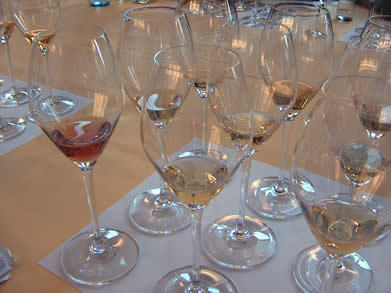|

Some
thoughts about wine tasting
‘Learn about wine’ texts tend to repeat themselves.
Worse still, I don’t think they address some of the key issues in
wine tasting in an intelligent manner. Can I do any better? Well,
I’ll give it a go. To start with I’d like to highlight some
thoughts which tasters, novice and expert alike, may find insightful.
Or they may not…
Trust
your own palate
Just as people vary in height or hair colour, you’d
expect to find some variation in taste and smell. But it’s the
nature of this variation that is interesting. People can be split into
groups according to their taste sensitivity, with the most sensitive
group being dubbed ‘supertasters’. It’s an interesting subject
that’s beyond the scope of this short piece: suffice to say, we are
likely to be living in rather different ‘taste worlds’, so do
trust your own palate.
But
our taste changes with experience and development
Kids have rather different tastes to adults. And even
when you are an adult, it’s possible to grow to like something that
you didn’t before. Some of the most compelling flavours are those
for which we need to acquire a taste. With wine, the more widely we
taste, our preferences are refined and we begin to understand what all
the fuss is about.
Colour
matters
The sense of flavour involved input from taste buds,
the nose, the sense of touch and even vision. Vision affects our
assessment of wine in quite profound ways, but we are seldom aware of
it. In an interesting experiment, researchers presented a white wine
to a panel of experts and asked them to describe it. A fortnight later
they presented the same white wine but coloured red with a neutral
food colouring. The experts used a different set of
red-wine-influenced words to describe this wine the second time
around. But the fact that experts can be fooled like this doesn’t
mean that wine tasting is a load of nonsense. Rather, it says
something about the importance of vision in interpreting our other
senses, and also the vital role that language plays in shaping our
assessment of wine. This leads nicely to the next point.
Words
for wine: am I missing something?
When I do tastings for non-expert groups, people are
always anxious that they are missing something because they find it
hard to come up with a long list of adjectives to describe the wine
they are drinking. If that applies to you, then don’t worry. Tastes
and smell are incredibly difficult to describe in words. What does a
plate of steak and chips taste like? Even a wine expert would be
stumped by that one. Part of learning about wine involves associating
words with specific smells and tastes. In many cases, the words wine
experts use don’t correspond well with what is in the wine; it’s
as if they have invented a code language for these sensory
impressions. It works, though, sort of – and it is a bit daunting to
newcomers. Researchers have shown that when experts are faced with a
wine they first decide what sort of wine it is, and then this shapes
the nature of the descriptors that they use. This leads to the sorts
of problems encountered by experts in the test described above.
Moving
beyond fruits and spices
Tasting notes frequently revolve around lists of
descriptors: usually fruits and spices. But think about a visual
scene. If I show you a picture and ask you to describe it, it
wouldn’t be much use for you to just describe the colours you see,
along with the shapes. We see the visual scene as a whole, and while
there are components that can be named which contribute to this scene
(e.g. flowers, trees, cars or people), we don’t describe them in
terms of visual detail (shapes, colours, textures, movements, etc.).
The perception of wine is a unified experience, yet we rarely take a
holistic approach in our descriptions; rather, we break the wine down
into rather elementary components. This all sounds a bit complex and
abstract, but what I am trying to say is that it is the impression of
the wine as a whole that really matters, and we need to find ways to
describe this in words.
Begin
to develop your own tasting vocabulary
So here are my two tips to help you begin getting more
out of your wine. First, taste and smell as many things as you can.
Get out the spice rack. Sniff the fruit and vegetable section. Think
about what you taste and smell. Second, no matter how inadequate you
feel, try to write down descriptions of the wine you taste. Read other
people’s tasting notes of the same wines if you can. After a while
you’ll begin to find that you have your own vocabulary for wine
tasting, which will help you develop your skills as a taster.
Back to top
|